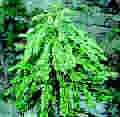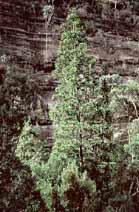
Wollemia nobilis (from the Home Page).

Wollemia nobilis (from the Home Page).

Clockwise from lower left: bark, pollen grain, foliage, cone scales, tree in habitat, two seedlings, pollen and seed cones, and fossil material [Christine Payne] (2).
Common Names
Wollemi pine.Taxonomic notes
Monotypic genus. This, the newest conifer, was discovered in August 1994. Of the other extant Araucariaceae, the new genus appears closest to Agathis, but it has many features in common with Cretaceous and early Tertiary fossil groups such as Araucarioides, and may be closer to these. Pollen also more closely resembles fossil pollen examples than pollen of either living genus (1). See the Remarks for further details.Description
Leaves on adult lateral shoots are one of the most distinctive features of the new discovery, being arranged to present four ranks, with two ranks at about 150-175° and the other two ranks lying between the first two at about 50-90° (1).Range
Currently known only from a very wet and sheltered gorge in the Wollemi National Park, in a rugged mountainous area of the Blue Mountains within 200 km north-west of Sydney in New South Wales, Australia (1). The wild population consists of about 40 adult plants and about 200 seedlings (5).Big Tree
Oldest
Dendrochronology
No use to date (late 1998).Ethnobotany
No use known before the tree's discovery. At this time, it is regarded as being at great risk from unauthorized collection and the Australian government has instituted a program to establish an ample stock of nursery plants to serve the desires of collectors and botanical gardens.Observations
Because the native stock is extremely small, it could easily by wiped out by collectors. Thus, its location is being kept secret. Efforts to reproduce the plant have been successful and seedlings will soon be distributed to botanical gardens and will be available to collectors.Remarks
DNA samples taken from several of the 39 remaining wild plants is showing no discernible variation, suggesting that the sole known population is entirely clonal (2).Australia's Royal Botanical Garden is very proud of Australia's newly-discovered conifer; it has its own home page, featuring descriptions and images (the source for the images used here).
This species is currently listed on the index of threatened Australian plant species.
"Adult and juvenile shoots of Wollemia differ in leaf arrangement, leaf shape, and cuticular features: in these features they are most similar to Araucaria. The cone scales have a long, distal spine reminiscent of Araucaria section Eutacta, but the winged seeds that are ontogenetically free from, and shed independently from, the cone scale are similar to Agathis. Shoots with variable leaf types, Araucaria-like cone scales, and Agathis- like winged seeds are found in several plant fossil assemblages from the Cretaceous of Australia; these fossil conifers, which had been recognized as araucarian, can now be favorably compared with Wollemia. Pollen of Wollemia is indistinguishable from the fossil pollen form-genus Dilwynites, which has a fossil record extending back to the Late Cretaceous in Australia and New Zealand. Reexamination of Mesozoic and Tertiary paleofloras will most probably reveal an important contribution of Wollemia to the fossil record of Araucariaceae" (3).
"Sequences were obtained for the rbcL gene from chloroplast DNA of the newly discovered Australian conifer Wollemia nobilis (Araucariaceae), 5 species of Araucaria and 4 species of Agathis. Phylogenetic analysis of our new data and other available sequences indicate that 1) Araucariaceae is monophyletic; 2) Agathis and Araucaria are both monophyletic; 3) Wollemia is the sister group to Agathis; 4) the Pinaceae are the sister group to all other conifers, although the monophyly of the conifers is not unequivocally demonstrated" (4).
Citations
(1) Wollemi Pine home page.(2) The Wollemi Pine - A Portrait.
(3) Chambers, T.Carrick, Andrew N. Drinnan and Stephen McLoughlin. 1998. Some morphological features of wollemi pine (Wollemia nobilis: Araucariaceae) and their comparison to Cretaceous plant fossils. International Journal of Plant Sciences 159: 160-171.
(4) Gilmore, S. and K. D. Hill. 1997. Relationships of the Wollemi Pine (Wollemia nobilis) and a molecular phylogeny of the Araucariaceae. Telopea 7: 275-291.
(5) Anonymous. 1998. Wollemi Pine (Wollemia nobilis) recovery plan. Hurstville, NSW: New South Wales National Parks and Wildlife Service. 69p. [This document available online as a PDF file from the Wollemi Pine Home Page (1).]
See also:
Anon. (1995). Fears for ancient pines after scavengers find secret grove. Sydney Morning Herald 24-02-95:1.
Anon. (1995). 'Extinct' native pine rediscovered [Wollemi pine, discovered in an almost inaccessible part of the Wollemi National Park, about 200 kms. west of Sydney, was believed to have become extinct 150 million years ago]. The Greener Times, Jan.:7.
Anon. (1995). Checks on site of rare trees. [Wollemi Pines] Sydney Morning Herald 28-02-95:5.
Greenaway, C. (1995). Jurassic pines in Wollemi Park. Wildlife Australia 32(1):3.
Hill, Ken D. 1997. The Wollemi Pine: A recently discovered Australian genus of Araucariaceae. American Journal of Botany 84(6) SUPPL., pp. 202-203.
Jones, W. (1995). Wollemi Pine - the missing link? [rediscovery of population of 23 adults and 16 juveniles in Wollemi National Park, N.S.W.]. On the Brink, 6 : 2.
Jones, W.G., K.D. Hill and J.M. Allen. 1996. Wollemia nobilis, a new living Australian genus and species in the Araucariaceae. Telopea 6(2-3).
Offord, C. (1996). Conserving the Wollemi Pine: an integrated approach. [Recovery Plan being prepared by ANCA. 'The simple act of visiting the site poses one of the greatest threats...' Danthonia 5(2) : 12-14.
Woodford, J. (1995). Intruders damage Wollemi pines. The Age 24-02-1995: 5.
[Wollemia] [Araucariaceae] [home]
This page is from the Gymnosperm Database
URL: http://www.geocities.com/~earlecj/ar/wo/index.htm
Edited by Christopher J. Earle
E-mail:earlecj@earthlink.com
Last modified on 19-Apr-1999